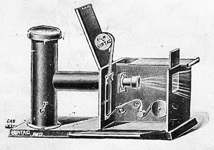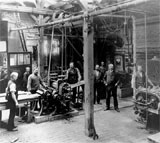| 1898 |
 Chronomedia index Chronomedia index
Numbers after entries link to the list of references. |
links and notes |
| February 5-11 |
Moments from the first class cricket match between New South Wales and England played at Sydney is filmed for screening at Sydney Polytechnic, 82 King Street, Sydney. (An unprecedented 1,739 runs were scored during the match, which NSW won by 239 runs.) |
|
| March |
The world's first film competition is held in Monte Carlo. The winner is Clément-Maurice Gratioulet, a (former) manager of Lumière exhibition activities, for Monaco vivant par les appareils cinématographiques. |
> 1900 |
| April 4 |
Auguste Baron files a second French patent application for an improved version of what is now called the Graphophonoscope. Several films are made by Baron and Félix Mesguiche using the system at a specially equipped studio in Asnières-sur-Seine, some on a unique 50mm film. Sound is recorded on wax cylinders with a maximum running time of four minutes, the phonograph linked electrically to a film camera. |
|
| April 29 |
First screening of a dramatic film made in Hungary, Siófoki Kaland, incorporated in a stage play called Mozgáfényképek (Moving Pictures). |
|
| spring |
First Greek commercial film show at Place Kolokotronis, Athens. |
|
| May |
The Gramophone Company is formed in the UK to sell Eldridge Johnson’s improved version of the disc player imported in kit form from the US. |
|
| November 18 |
  British film-maker Birt Acres launches the Birtac film camera [left], which uses 17.5mm film and can also be used as a projector [right]. A 16-page manual The 'Birtac' for home animated photography is published by Northern Photographic Works. British film-maker Birt Acres launches the Birtac film camera [left], which uses 17.5mm film and can also be used as a projector [right]. A 16-page manual The 'Birtac' for home animated photography is published by Northern Photographic Works. |
|
| December |
 Emile Berliner returns from the USA to Europe. With his brother Joseph he forms Deutsche Grammophon Gesellschaft in Hannover, Germany and builds the first plant for pressing gramophone discs [right]. The discs are single-sided and embossed on the non-playing side 'Reproduced in Hannover'. Emile Berliner returns from the USA to Europe. With his brother Joseph he forms Deutsche Grammophon Gesellschaft in Hannover, Germany and builds the first plant for pressing gramophone discs [right]. The discs are single-sided and embossed on the non-playing side 'Reproduced in Hannover'. |
Picture source: DGG |
| • |
First Bulgarian commercial film show is given in Sofia by Ferencz Echer. |
|
| • |
Film of an operation at the Surgical Centre of the University of Berlin is shot by Oskar Messter and used for teaching at Kiel University. |
|
| • |
Film is used by Alfred Cord Haddon to record tribal dances and other customs of Torres Strait Islanders during a Cambridge University anthropological field trip. |
|
| • |
First film produced in Cuba: El Brujo Desapareciendo (The Disappearing Magician), directed by José E Casesus. |
|
| • |
After the dismissal of John Le Coutour from Gaumont's London office, the Gaumont Company is formed in London by A C and R C Bromhead as distribution subsidiary of Léon Gaumont in France, with an office at 25 Cecil Court, off Charing Cross Road, London, near which other film companies begin to congregate. |
|
| • |
Vitagraph Company of America is founded by Albert Smith and James Stuart Blackton to make films for inclusion in their vaudeville performances. |
|
| • |
Alfonso Segreto shoots the first film in Brazil: scenes of Guanabara Bay. |
|
| • |
Félix Oliver makes the first film in Uruguay: Una carrera de ciclismo en el velódromo de Arroyo Seco (Cycle race at the Arroyo Seco velodrome). |
See 1900. |
| • |
Short comedy films are made in Prague, Czechoslovakia by Jan Krizenecky of performances by Josef Šváb-Malostranský, a Bohemian cabaret artiste: including Dostavenicko ve Mlynici (released in English as ‘Rendez-vous at the Grinding Room’) and Vystavni Parkar a Lepic Plakatu (The Bill-Sticker and the Sausage Vendor). |
|
| • |
Carl Zeiss photographic company in Leipzig, Germany is working on the use of anamorphic lenses for film cameras. |
|
| • |
Proposal that an archive of films should be created is made by Boleslaw Matuszewski, a Polish cinematographer employed by the Lumières, in a booklet, Une nouvelle source de l'histoire (A New Source of History). He proposes that 'it should have a museum section, a library and an archive'. He argues in favour of statutory deposit of films to preserve the historical record and visual heritage.
In a second booklet, La photographie animée: Ce qu'elle est, ce qu'elle doit être (Animated photography: What it is, what is should be), published around the same time, Matuszewski provides perhaps the first work on film theory. |
> 1910 |
| • |
System of photo-telegraphy is introduced in the USA by Hummell. |
|
| • |
Emile Berliner applies for a patent on a 'puzzle' disc that contains two concentric grooves, so that two different audio programmes can be heard, depending on where the stylus is placed on the edge of the disc. |
> 1955 |
| • |
UK retail chain Boots establishes its first Booklovers' Library operations in stores that have a stationery department. |
> 1903 |
| • |
US patent for a long horn to amplify sound is granted to Eldridge R Johnson of Camden, New Jersey. |
|





















